Research News & Highlights
UKI Discs Meeting 2024 to be hosted at the University of Warwick
Our discs group recently started the UK & Ireland (UKI) Discs community, where we aim to bring together the disc communities across the UK & Ireland for those working on astrophysical discs on various scales, from circumplanetary to galactic discs. We are excited to announce the first UKI Discs Meeting will be hosted at the University of Warwick from the 9th - 11th of September 2024 and will focus on protoplanetary discs and debris discs (including white dwarf discs). To register and find out more, follow the link hereLink opens in a new window.
The abstract submission deadline for talks/posters is the 12th of May 2024.

Continuing to hide signatures of gravitational instability in protoplanetary discs with planets
Sahl Rowther, Rebecca Nealon, Farzana Meru
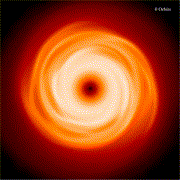
We conduct gas and dust hydrodynamical simulations of protoplanetary discs with one and two embedded planets to determine the impact that a second planet located further out in the disc has on the potential for subsequent planet formation in the region locally exterior to the inner planet. We show how the presence of a second planet has a strong influence on the collection of solid material near the inner planet, particularly when the outer planet is massive enough to generate a maximum in the disc’s pressure profile. This effect in general acts to reduce the amount of material that can collect in a pressure bump generated by the inner planet. When viewing the inner pressure bump as a location for potential subsequent planet formation of a third planet, we therefore expect that the mass of such a planet will be smaller than it would be in the case without the outer planet, resulting in a small planet being sandwiched between its neighbours – this is in contrast to the expected trend of increasing planet mass with radial distance from the host star. We show that several planetary systems have been observed that do not show this trend but instead have a smaller planet sandwiched in between two more massive planets. We present the idea that such an architecture could be the result of the subsequent formation of a middle planet after its two neighbours formed at some earlier stage.
"Sandwiched" Planet Formation
Matthew Pritchard, Farzana Meru
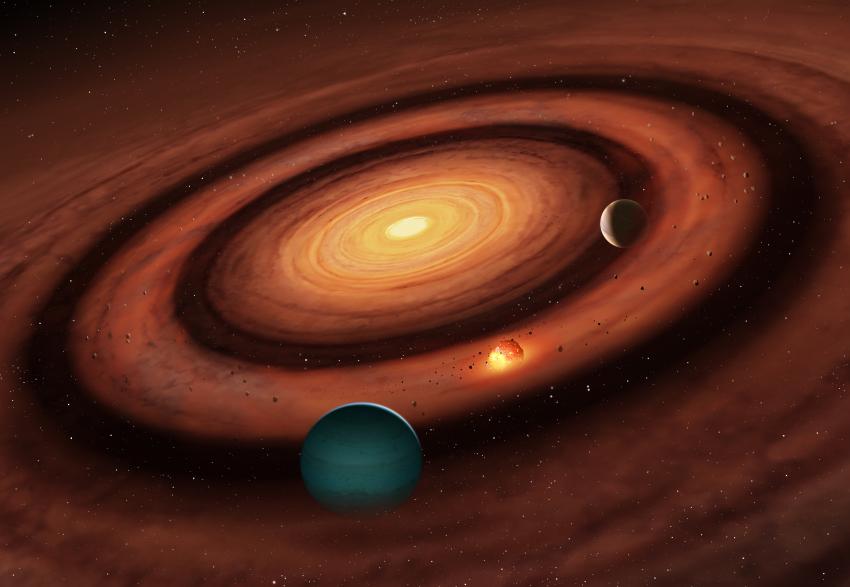
We conduct gas and dust hydrodynamical simulations of protoplanetary discs with one and two embedded planets to determine the impact that a second planet located further out in the disc has on the potential for subsequent planet formation in the region locally exterior to the inner planet. We show how the presence of a second planet has a strong influence on the collection of solid material near the inner planet, particularly when the outer planet is massive enough to generate a maximum in the disc’s pressure profile. This effect in general acts to reduce the amount of material that can collect in a pressure bump generated by the inner planet. When viewing the inner pressure bump as a location for potential subsequent planet formation of a third planet, we therefore expect that the mass of such a planet will be smaller than it would be in the case without the outer planet, resulting in a small planet being sandwiched between its neighbours – this is in contrast to the expected trend of increasing planet mass with radial distance from the host star. We show that several planetary systems have been observed that do not show this trend but instead have a smaller planet sandwiched in between two more massive planets. We present the idea that such an architecture could be the result of the subsequent formation of a middle planet after its two neighbours formed at some earlier stage.
ALMA and Keck analysis of Fomalhaut field sources: JWST's Great Dust Cloud is a background object
Grant M. Kennedy, Joshua B. Lovell, Paul Kalas, Michael P. Fitzgerald
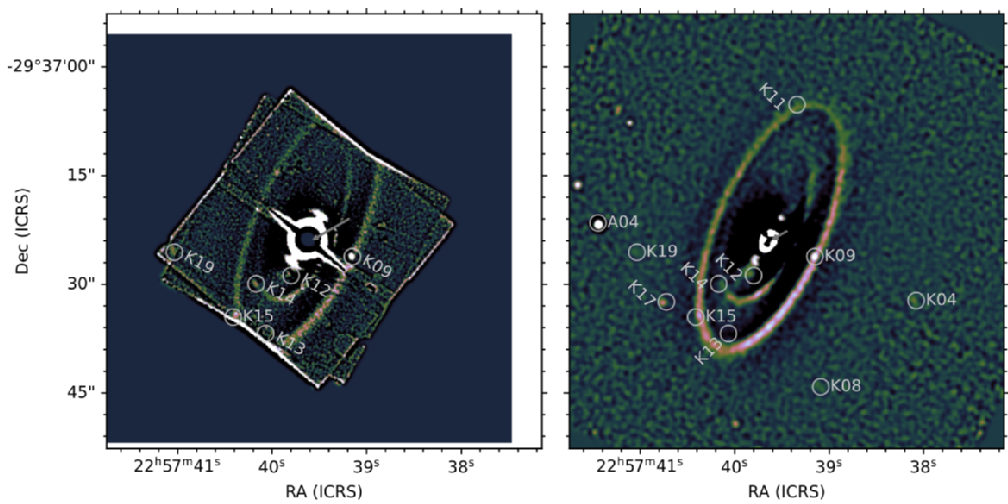
At 7.7 pc, the A-type star Fomalhaut hosts a bright debris disk with multiple radial components. The disk is eccentric and misaligned, strongly suggesting that it is sculpted by interaction with one or more planets. Compact sources are now being detected with JWST, suggesting that new planet detections may be imminent. However, to confirm such sources as companions, common proper motion with the star must be established, as with unprecedented sensitivity comes a high probability that planet candidates are actually background objects. Here, ALMA and Keck observations of Fomalhaut are found to show significant emission at the same sky location as multiple compact sources in JWST MIRI coronagraphic observations, one of which has been dubbed the "Great Dust Cloud" because it lies within the outer belt. Since the ground-based data were obtained between 6 to 18 years prior to the JWST observations, these compact sources are unlikely to be common proper motion companions to Fomalhaut. More generally, this work illustrates that images collected at a range of wavelengths can be valuable for rejecting planet candidates uncovered via direct imaging with JWST.
Planetesimals drifting through dusty and gaseous white dwarf debris discs: Types I, II and III-like migration
Dimitri Veras, Shigeru Ida, Evgeni Grishin, Scott J. Kenyon, Benjamin C. Bromley
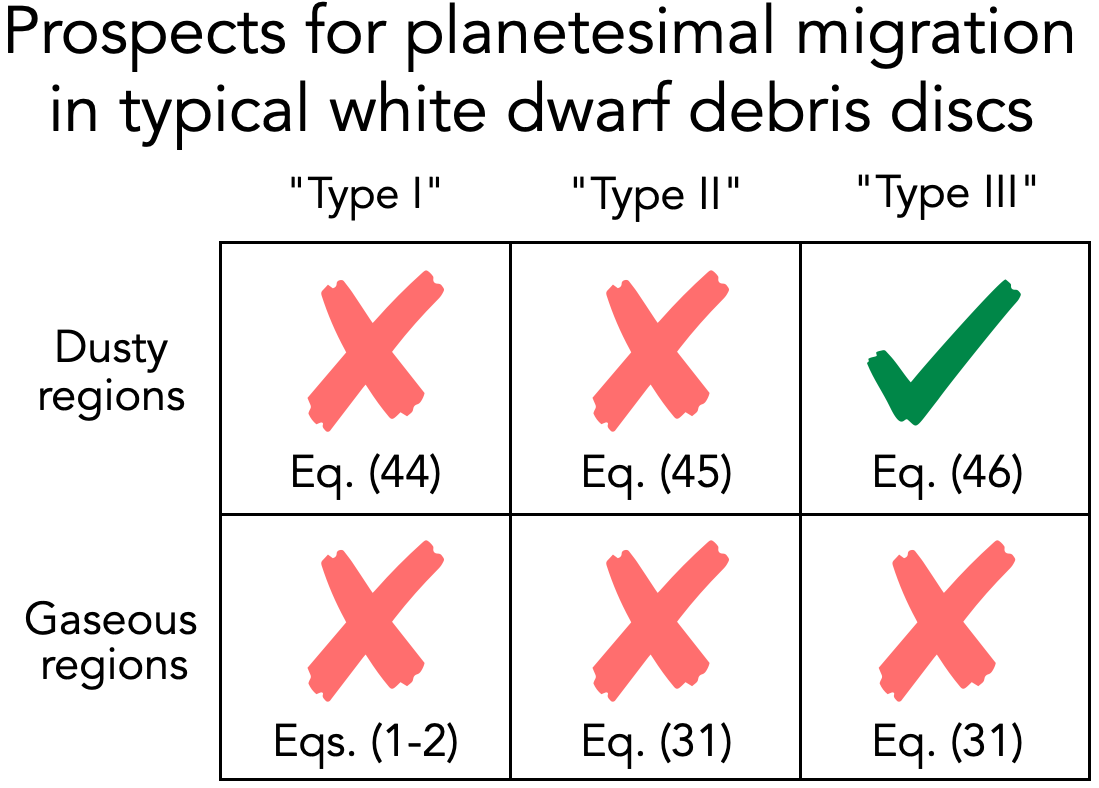
The suite of over 60 known planetary debris discs which orbit white dwarfs, along with detections of multiple minor planets in these systems, motivate investigations about the migration properties of planetesimals embedded within the discs. Here, we determine whether any of the migration regimes which are common in (pre-)main-sequence protoplanetary discs, debris discs and ring systems could be active and important in white dwarf discs. We investigate both dust-dominated and gas-dominated regions, and quantitatively demonstrate that Type I and Type II migration, as well as their particulate disc analogues, are too slow to be relevant in white dwarf discs. However, we find that the analogue of Type III migration for particulate discs may be rapid in the dusty regions of asteroid- or moon-generated (>1018 kg) white dwarf discs, where a planetesimal exterior to its Roche radius may migrate across the entire disc within its lifetime. This result holds over a wide range of disc boundaries, both within and exterior to 1R⊙, and such that the probability of migration occurring increases with higher disc masses.
The Bardeen-Petterson effect in accreting supermassive black hole binaries: disc breaking and critical obliquity
Rebecca Nealon, Enrico Ragusa, Davide Gerosa, Giovanni Rosotti, Riccardo Barbieri
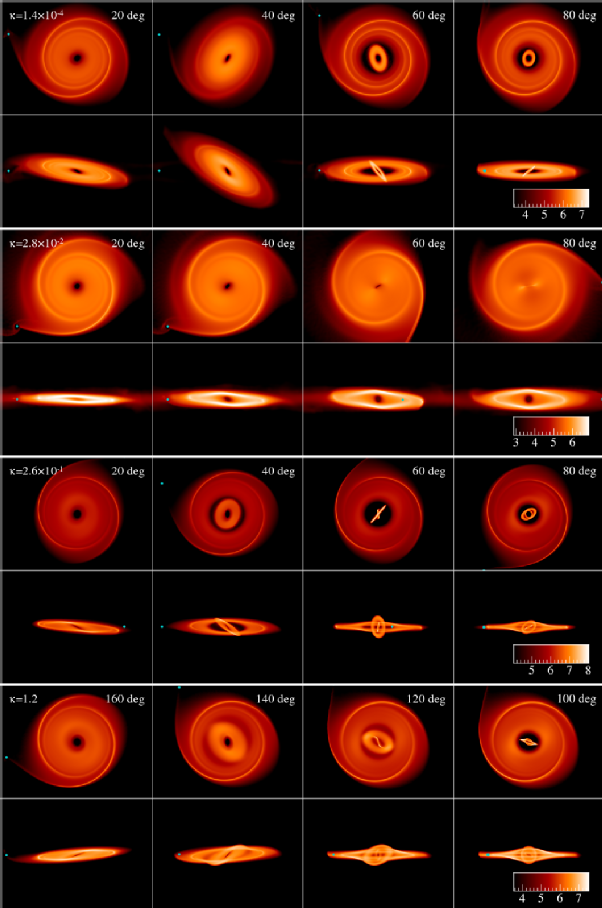
The inspiral of supermassive black hole (BH) binaries in a gas-rich environment is driven by the presence of an accretion disc and viscous interactions tend to align the spin of the BHs with the orbital angular momentum of the disc. Recent work introduced a new iterative approach to describe the alignment process and the resulting non-linear evolution of the surrounding warped accretion disc. Their model predicted that BH spins reach either full alignment or a 'critical obliquity' where solutions to the warp equations cease to exist. In this paper, we show that this critical region corresponds to the disc breaking phenomenon, where the disc is disrupted into two or more discrete sections. We use 3D hydrodynamical simulations to (i) recover the predictions of the semi-analytic model and (ii) unveil a richer phenomenology where the disc exhibits either unsuccessful, single and multiple breaks. We additionally identify hydrodynamic effects such as spiral arms that are able to stabilize the disc against breaking beyond criticality. Our results show that when disc breaking occurs, the ability of BHs and disc to align is compromised and in some cases even prevented as the binary inspirals.
Evolving extrasolar Kirkwood gaps
Dimitri Veras, Nikolaos Georgakarakos, Ian Dobbs-Dixon
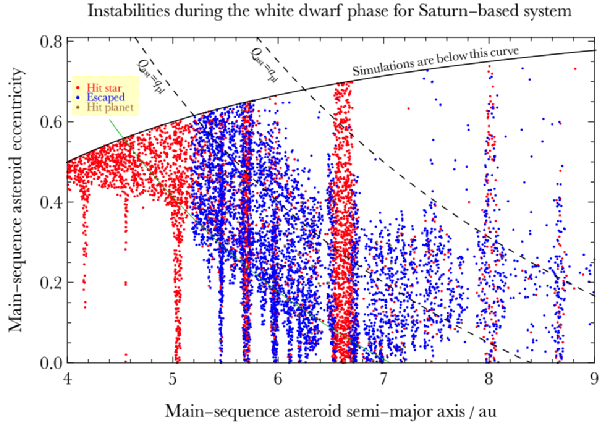
The evolution of planetary debris discs, such as extrasolar analogues of the solar system's Main Belt and Kuiper Belt, crucially determine how host stars are polluted with planetary metals. This new paper presents high-resolution resonant portraits of these debris discs as they evolve beyond the main-sequence and interact with a surviving planet in the system. We find that evolving resonant structure can be accurately bound with only main-sequence values by computing a maximum libration width as a function of asteroid longitude of pericentre. We also quantify the relative efficiency of mean motion resonances of different orders to stabilize versus destabilize asteroid orbits during both the giant branch and white dwarf phases. The 4:1, 3:1 and 2:1 resonances represent efficient polluters of white dwarfs, and even when in the orbit-crossing regime, both the 4:3 and 3:2 resonances can retain small reservoirs of asteroids in stable orbits throughout giant branch and white dwarf evolution.
RAS Specialist Meeting - Formation, Evolution and Dispersal of Protoplanetary Discs
Amena Faruqi -- Simulating the Transit of a Binary System by a Circumbinary Disc in the HD98800 System
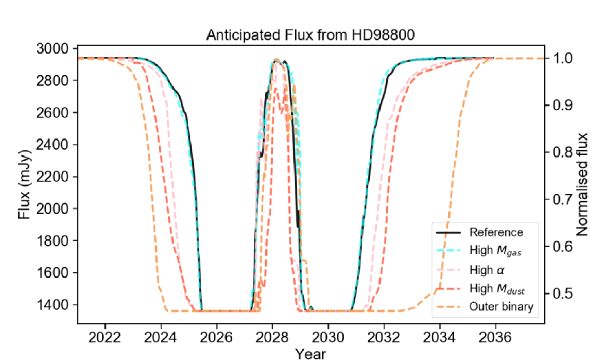
The properties of circumbinary discs play a significant role in star-disc interactions in binary systems. However, there are gaps in our current understanding of how various disc properties, such as the disc mass, viscosity, and dust-to-gas ratio, can affect the dynamics and evolution of such a system. In order to better understand the influence of these properties, it would be ideal to study a system where the stellar parameters are well-constrained, and the disc can be imaged. One such system is the HD98800 system, a quadruple star system consisting of two binaries, AaAb and BaBb, one of which (BaBb) has been observed to have a circumbinary protoplanetary disc encircling it. In 2026, it has been predicted that the circumbinary disc of BaBb will pass in front of AaAb. This provides a rare opportunity – analysing the light curve of the system during this transit could allow us to constrain certain properties of the disc. The goal of this research is to inform future observations and subsequent study of the system and transit, as well as providing some insight into the properties of circumbinary protoplanetary discs.
In this presentation, I will discuss my research using hydrodynamical simulations and radiative transfer modelling to create synthetic observations of the HD98800 system and anticipated transit. To consider how observations differ as a result of variations in disc properties, a grid of models defined by a parameter space was created. I will discuss how this set of results can be compared to identify features in the synthetic light curves that can be used to make inferences about disc properties. I will also consider how my synthetic observations compare to past observations of the system and more broadly, how certain disc properties can be constrained using simulation data.
Debris Discs: Home and Abroad 2022
Raphael Bendahan-West -- Automated Search for Spectroscopic Exocomet Transits
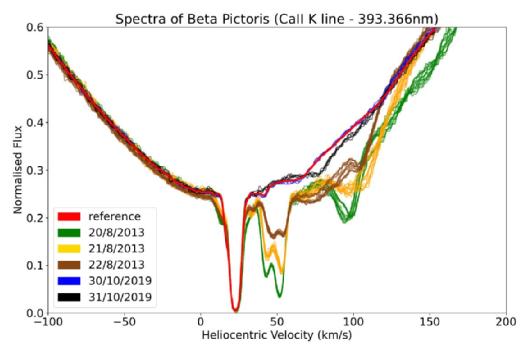
Exocomets are analogues of solar system comets, with the main difference being that they orbit stars other than the Sun. These extrasolar comets can be thought of as small icy planetesimals that were left unused during the planet formation phase of a system. Although being “leftover” dust agglomerates, exocomets tend to be part of the most pristine objects in a system, enclosing primordial information about the early phases of planetary formation.
The field of exocomets has been built around the unmatched number of detections made in the circumstellar disc of the archetypal star Beta Pictoris. An exocomet detection is identified by variable absorption features around atomic lines in a stellar spectrum (typically around the ionised Calcium doublet), which can be explained by the interaction between the light emitted by a star and the transiting gas that is in and trailing an exocomet coma. Variability in the CaII doublet has been observed around approximately 30 different stars – certain detections being clearer than others, emphasising the rarity and difficulty to observe such events.
In this talk, I will show results from an automated search through the HARPS archive for signs of exocomet transits. Such a spectroscopic survey is unprecedented mainly due to the large quantity and wide variety of stars being observed. This talk will introduce our newly developed automated search algorithm that quantifies the rate of CaII exocomet absorption events in archival spectra, with the goal to estimate the occurrence rate of transiting exocomets.
Azib Norazman -- An Automated Search for Transiting Exocomets with TESS
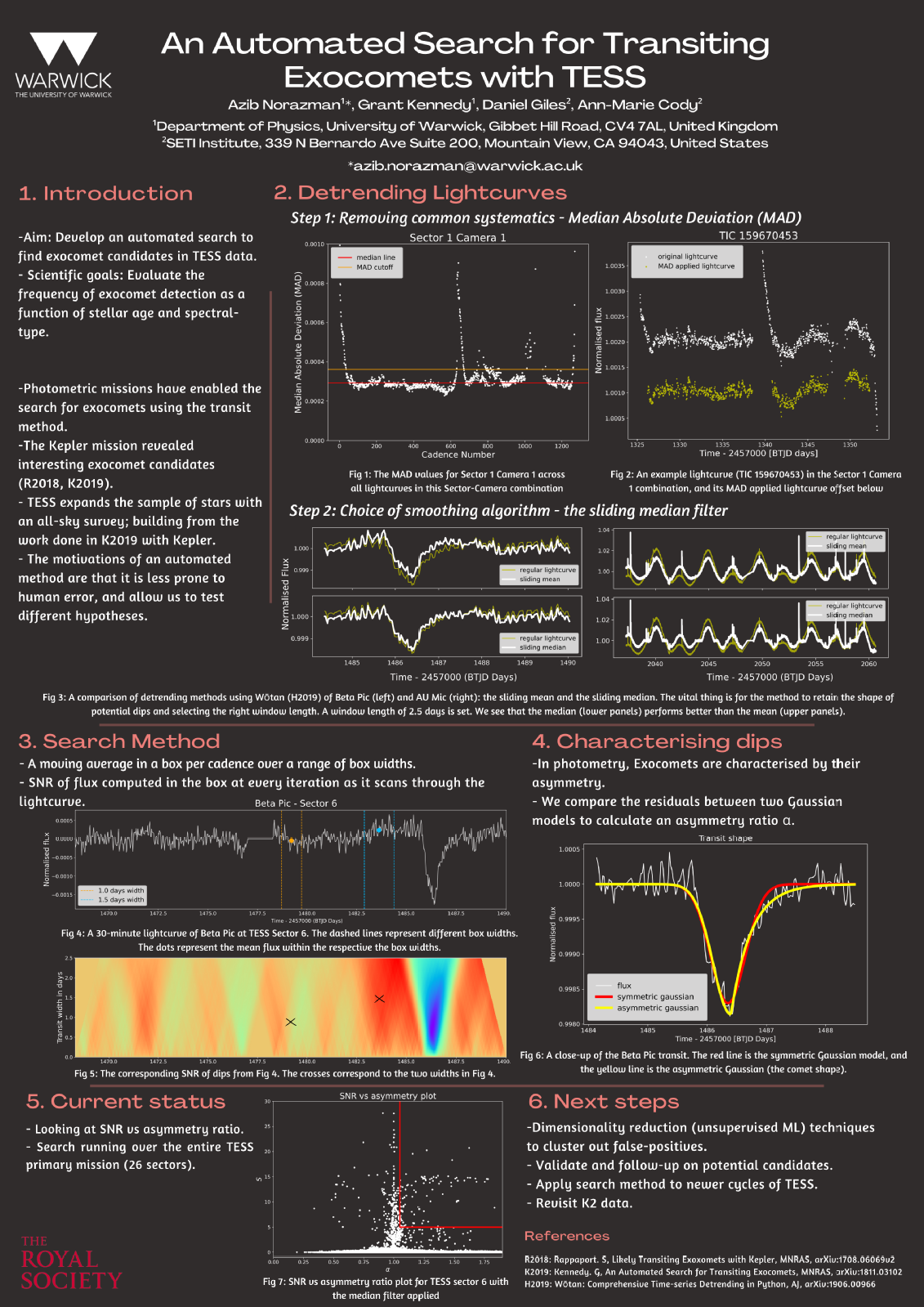
The term exocomets refers to analogues of our Solar System comets. They are small icy planetesimal bodies that orbit stars other than the Sun and are thought to be the remnants of exoplanet formation. In recent years, there have been a small number of stars that have unique asymmetric dips in their transits from photometric data that cannot be caused by a planet transit. The most prominent example of this so far are from the lightcurves of Beta Pictoris, a young A-type star. Recent literature has also indicated that exocomet detections are more likely in younger, A/F-type stars. As the TESS mission carries out an all-sky survey, there is now the opportunity to explore this hypothesis further and explore the detection rates of exocomets with relation to the spectral type of their host star- uncovering the occurrence rates as a function of spectral type and stellar age. A simple automated method to detect exocomet transits was developed for the Kepler mission. As TESS expands the sample of stars over the whole sky, a plethora of star systems will be explored. However, the nature of the all-sky search results in a wide range of astrophysical variability in addition to the different systematics the spacecraft has compared to Kepler. Therefore, development of the search method for TESS is essential. We present the automated search algorithm used to find potential asymmetric transit dips in TESS, and the results of my search at the time of the conference.
Rocking shadows in protoplanetary discs
Rebecca Nealon, Daniel Price and Christophe Pinte
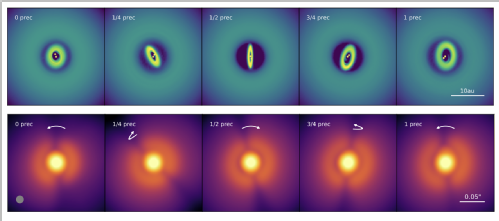
Astronomers from the University of Warwick reveal a new phenomenon dubbed the “rocking shadow” effect that describes how discs in forming planetary systems are oriented, and how they move around their host star. The effect also gives clues as to how they might evolve with time. Dr Rebecca Nealon presented the new work this week at the 2022 National Astronomy Meeting at the University of Warwick.
